#Heptapyrgion
Text


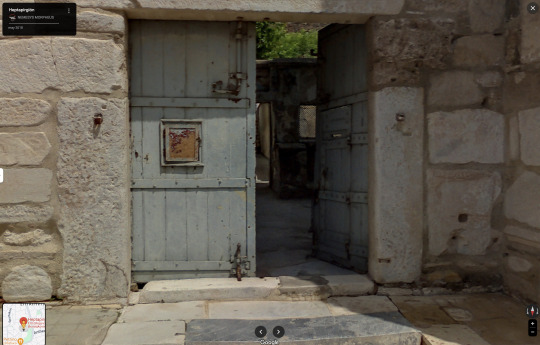
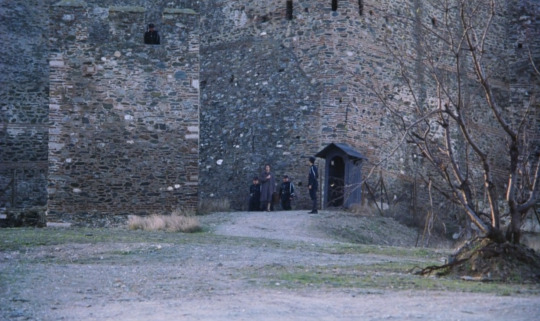

Τριλογία: Το λιβάδι που δακρύζει / Trilogy: The Weeping Meadow
Theodoros Angelopoulos. 2004
Prison
Επταπύργιο, Eptapirgiou 130, Thessaloniki 546 34, Greece
See in map
See in imdb
#theo angelopoulos#prison#heptapyrgion#alexandra aidini#trilogy#the weeping meadow#Τριλογία: Το λιβάδι που δακρύζει#thessaloniki#macedonia#movie#cinema#film#location#google maps#street view#2004
19 notes
·
View notes
Text
Kaffee mit Aussicht: Castra All Day Terrace Bar, Thessaloniki
Hoch über der Hauptstadt Makedoniens thront das Heptapyrgion, die alte Festung. Schon von hier gibt es einen phantastischen Blick über Stadt, Hafen und Meer – nur leider keinen Kaffee! Trotzdem hat sich der lange und bisweilen etwas mühsame Aufstieg gelohnt. Fanden auch einige Studenten und andere junge Leute, die auf einem kleinen Vorsprung auf den Sonnenuntergang warteten und sich dabei in…
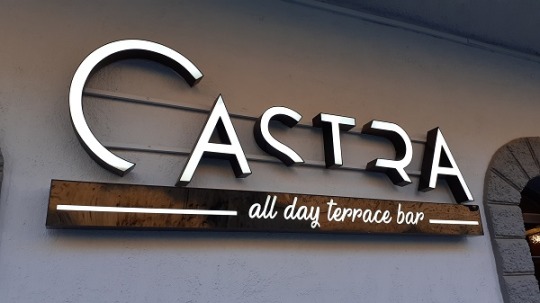
View On WordPress
#Cappuccino freddo#Cappuccino fredo#Castra#Castra All Day Terrace Bar#Freddo#Freddo Cappuccino#Fredo-Cappuccino#Heptapyrgion#Sonnenuntergang#Sundown#Thessaloniki#Trigonenturm
0 notes
Video
youtube
Explore Heptapyrgion Fortress: A Historic Landmark in Thessaloniki.We are taking you on a journey to the magnificent Heptapyrgion Yedi Koule Fortress of Thessaloniki. This impressive structure boasts a rich history and offers breathtaking views of the city. Join us as we uncover the secrets and stories behind this ancient stronghold. Where exactly is it? What about its history? Can you visit it now? Let's see!
1 note
·
View note
Photo

Yedi Kuleh Kapusu
The next gate is Yedi Kuleh Kapusu (Gate of the Seven Towers), the first public gate; a Byzantine Eagle carved on the inside is still visible. The tower to the right of this gate bears a Turkish inscription, and the date 1168 of the Hegira. The two medallions, of which traces are still visible, seem to have once been ornamented with carvings.
Yedi Kuleh (The Seven Towers) is the Byzantine citadel, variously styled Cyclobion or Strongylon, from its circular form, Pentapyrgion, from its five towers, and subsequently Heptapyrgion, on the increase of the number of towers to seven. The present towers were built on the site of the old ones by Sultan Muhammad II., and were used as a treasury. The wooden roofs were subsequently removed, owing to the frequent outbreaks of fire. Of the seven towers four are now left standing, the other three having been destroyed by an earthquake in 1758.
Treacherous intrigues of Sultan
The citadel served as a place of detention for state prisoners, many of whom were quietly strangled within its walls ; amongst others, Sultan Osman II., who, at the age of eighteen, fell a victim to the treacherous intrigues of Sultan Mustapha and the discontent of the mutinous Janissaries. In the Seven Towers it was also customary for the Turks, while hostilities lasted, to imprison the ambassadors of foreign countries with which the Porte was at war. The last ambassador thus detained was the French ambassador in 1798, who was kept imprisoned for three years. Since that date the pressure brought to bear upon the Porte by the French general Sebastiani, and the British ambassador Mr. Charles Arbuthnot, caused the Turks to give up this custom. Several Latin and French mural inscriptions on the left of the entrance to the dungeon have recently been effaced by some Turks.
This tower, which is at the E.S.E. corner of the citadel, contains a solid marble staircase leading to the top, and commands a splendid view of the Marmora shores, of Stambul and the outlying suburbs as far as San Stefano, and of the coast and mountains of Asia Minor and the Islands. The carving over the partly walled – up gate opposite the entrance leading to the Golden Gate represents the Labarum, the standard of the Byzantine Emperors. A flight of steps in a dark passage on the left of this gate leads to the dungeons to which obnoxious sultans were once consigned.
Only one of the two dungeons has two windows, and these too high and too small to have been any consolation to the unfortunate inmate, whose captivity, however, was in most cases terminated at an early stage by the bowstring. Visitors to this part of the citadel should provide themselves with a lantern, which is to be obtained from the doorkeeper. Several crosses are still to be seen carved over the gate opposite the Golden Gate. One of the graves under the laurel and pomegranate trees in the garden is that of Ahmed Kiupruli Pasha, who was hanged on his return from the taking of Candia after a twenty-four years’ siege. The Seven Towers and the adjoining land are now in charge of the Imperial Museum of Antiquities. Admission tc the citadel piastres (5d.) per person.
1 note
·
View note
Photo

Yedi Kuleh Kapusu
The next gate is Yedi Kuleh Kapusu (Gate of the Seven Towers), the first public gate; a Byzantine Eagle carved on the inside is still visible. The tower to the right of this gate bears a Turkish inscription, and the date 1168 of the Hegira. The two medallions, of which traces are still visible, seem to have once been ornamented with carvings.
Yedi Kuleh (The Seven Towers) is the Byzantine citadel, variously styled Cyclobion or Strongylon, from its circular form, Pentapyrgion, from its five towers, and subsequently Heptapyrgion, on the increase of the number of towers to seven. The present towers were built on the site of the old ones by Sultan Muhammad II., and were used as a treasury. The wooden roofs were subsequently removed, owing to the frequent outbreaks of fire. Of the seven towers four are now left standing, the other three having been destroyed by an earthquake in 1758.
Treacherous intrigues of Sultan
The citadel served as a place of detention for state prisoners, many of whom were quietly strangled within its walls ; amongst others, Sultan Osman II., who, at the age of eighteen, fell a victim to the treacherous intrigues of Sultan Mustapha and the discontent of the mutinous Janissaries. In the Seven Towers it was also customary for the Turks, while hostilities lasted, to imprison the ambassadors of foreign countries with which the Porte was at war. The last ambassador thus detained was the French ambassador in 1798, who was kept imprisoned for three years. Since that date the pressure brought to bear upon the Porte by the French general Sebastiani, and the British ambassador Mr. Charles Arbuthnot, caused the Turks to give up this custom. Several Latin and French mural inscriptions on the left of the entrance to the dungeon have recently been effaced by some Turks.
This tower, which is at the E.S.E. corner of the citadel, contains a solid marble staircase leading to the top, and commands a splendid view of the Marmora shores, of Stambul and the outlying suburbs as far as San Stefano, and of the coast and mountains of Asia Minor and the Islands. The carving over the partly walled – up gate opposite the entrance leading to the Golden Gate represents the Labarum, the standard of the Byzantine Emperors. A flight of steps in a dark passage on the left of this gate leads to the dungeons to which obnoxious sultans were once consigned.
Only one of the two dungeons has two windows, and these too high and too small to have been any consolation to the unfortunate inmate, whose captivity, however, was in most cases terminated at an early stage by the bowstring. Visitors to this part of the citadel should provide themselves with a lantern, which is to be obtained from the doorkeeper. Several crosses are still to be seen carved over the gate opposite the Golden Gate. One of the graves under the laurel and pomegranate trees in the garden is that of Ahmed Kiupruli Pasha, who was hanged on his return from the taking of Candia after a twenty-four years’ siege. The Seven Towers and the adjoining land are now in charge of the Imperial Museum of Antiquities. Admission tc the citadel piastres (5d.) per person.
0 notes
Photo
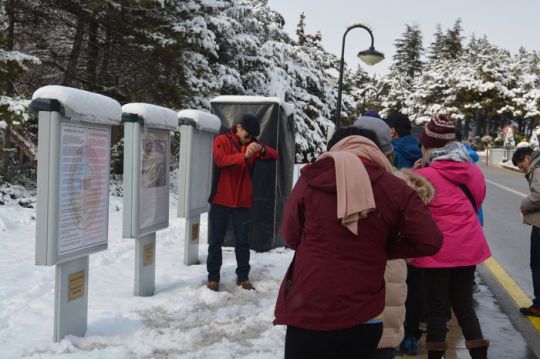
Yedi Kuleh Kapusu
The next gate is Yedi Kuleh Kapusu (Gate of the Seven Towers), the first public gate; a Byzantine Eagle carved on the inside is still visible. The tower to the right of this gate bears a Turkish inscription, and the date 1168 of the Hegira. The two medallions, of which traces are still visible, seem to have once been ornamented with carvings.
Yedi Kuleh (The Seven Towers) is the Byzantine citadel, variously styled Cyclobion or Strongylon, from its circular form, Pentapyrgion, from its five towers, and subsequently Heptapyrgion, on the increase of the number of towers to seven. The present towers were built on the site of the old ones by Sultan Muhammad II., and were used as a treasury. The wooden roofs were subsequently removed, owing to the frequent outbreaks of fire. Of the seven towers four are now left standing, the other three having been destroyed by an earthquake in 1758.
Treacherous intrigues of Sultan
The citadel served as a place of detention for state prisoners, many of whom were quietly strangled within its walls ; amongst others, Sultan Osman II., who, at the age of eighteen, fell a victim to the treacherous intrigues of Sultan Mustapha and the discontent of the mutinous Janissaries. In the Seven Towers it was also customary for the Turks, while hostilities lasted, to imprison the ambassadors of foreign countries with which the Porte was at war. The last ambassador thus detained was the French ambassador in 1798, who was kept imprisoned for three years. Since that date the pressure brought to bear upon the Porte by the French general Sebastiani, and the British ambassador Mr. Charles Arbuthnot, caused the Turks to give up this custom. Several Latin and French mural inscriptions on the left of the entrance to the dungeon have recently been effaced by some Turks.
This tower, which is at the E.S.E. corner of the citadel, contains a solid marble staircase leading to the top, and commands a splendid view of the Marmora shores, of Stambul and the outlying suburbs as far as San Stefano, and of the coast and mountains of Asia Minor and the Islands. The carving over the partly walled – up gate opposite the entrance leading to the Golden Gate represents the Labarum, the standard of the Byzantine Emperors. A flight of steps in a dark passage on the left of this gate leads to the dungeons to which obnoxious sultans were once consigned.
Only one of the two dungeons has two windows, and these too high and too small to have been any consolation to the unfortunate inmate, whose captivity, however, was in most cases terminated at an early stage by the bowstring. Visitors to this part of the citadel should provide themselves with a lantern, which is to be obtained from the doorkeeper. Several crosses are still to be seen carved over the gate opposite the Golden Gate. One of the graves under the laurel and pomegranate trees in the garden is that of Ahmed Kiupruli Pasha, who was hanged on his return from the taking of Candia after a twenty-four years’ siege. The Seven Towers and the adjoining land are now in charge of the Imperial Museum of Antiquities. Admission tc the citadel piastres (5d.) per person.
0 notes
Photo

Yedi Kuleh Kapusu
The next gate is Yedi Kuleh Kapusu (Gate of the Seven Towers), the first public gate; a Byzantine Eagle carved on the inside is still visible. The tower to the right of this gate bears a Turkish inscription, and the date 1168 of the Hegira. The two medallions, of which traces are still visible, seem to have once been ornamented with carvings.
Yedi Kuleh (The Seven Towers) is the Byzantine citadel, variously styled Cyclobion or Strongylon, from its circular form, Pentapyrgion, from its five towers, and subsequently Heptapyrgion, on the increase of the number of towers to seven. The present towers were built on the site of the old ones by Sultan Muhammad II., and were used as a treasury. The wooden roofs were subsequently removed, owing to the frequent outbreaks of fire. Of the seven towers four are now left standing, the other three having been destroyed by an earthquake in 1758.
Treacherous intrigues of Sultan
The citadel served as a place of detention for state prisoners, many of whom were quietly strangled within its walls ; amongst others, Sultan Osman II., who, at the age of eighteen, fell a victim to the treacherous intrigues of Sultan Mustapha and the discontent of the mutinous Janissaries. In the Seven Towers it was also customary for the Turks, while hostilities lasted, to imprison the ambassadors of foreign countries with which the Porte was at war. The last ambassador thus detained was the French ambassador in 1798, who was kept imprisoned for three years. Since that date the pressure brought to bear upon the Porte by the French general Sebastiani, and the British ambassador Mr. Charles Arbuthnot, caused the Turks to give up this custom. Several Latin and French mural inscriptions on the left of the entrance to the dungeon have recently been effaced by some Turks.
This tower, which is at the E.S.E. corner of the citadel, contains a solid marble staircase leading to the top, and commands a splendid view of the Marmora shores, of Stambul and the outlying suburbs as far as San Stefano, and of the coast and mountains of Asia Minor and the Islands. The carving over the partly walled – up gate opposite the entrance leading to the Golden Gate represents the Labarum, the standard of the Byzantine Emperors. A flight of steps in a dark passage on the left of this gate leads to the dungeons to which obnoxious sultans were once consigned.
Only one of the two dungeons has two windows, and these too high and too small to have been any consolation to the unfortunate inmate, whose captivity, however, was in most cases terminated at an early stage by the bowstring. Visitors to this part of the citadel should provide themselves with a lantern, which is to be obtained from the doorkeeper. Several crosses are still to be seen carved over the gate opposite the Golden Gate. One of the graves under the laurel and pomegranate trees in the garden is that of Ahmed Kiupruli Pasha, who was hanged on his return from the taking of Candia after a twenty-four years’ siege. The Seven Towers and the adjoining land are now in charge of the Imperial Museum of Antiquities. Admission tc the citadel piastres (5d.) per person.
0 notes
Photo
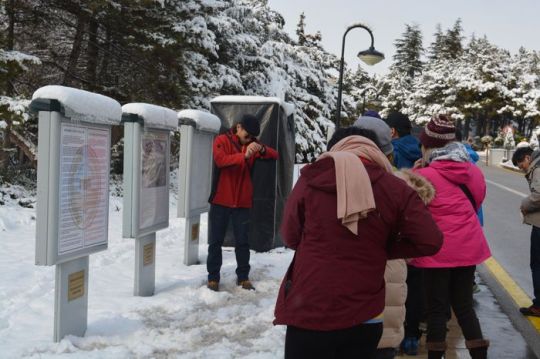
Yedi Kuleh Kapusu
The next gate is Yedi Kuleh Kapusu (Gate of the Seven Towers), the first public gate; a Byzantine Eagle carved on the inside is still visible. The tower to the right of this gate bears a Turkish inscription, and the date 1168 of the Hegira. The two medallions, of which traces are still visible, seem to have once been ornamented with carvings.
Yedi Kuleh (The Seven Towers) is the Byzantine citadel, variously styled Cyclobion or Strongylon, from its circular form, Pentapyrgion, from its five towers, and subsequently Heptapyrgion, on the increase of the number of towers to seven. The present towers were built on the site of the old ones by Sultan Muhammad II., and were used as a treasury. The wooden roofs were subsequently removed, owing to the frequent outbreaks of fire. Of the seven towers four are now left standing, the other three having been destroyed by an earthquake in 1758.
Treacherous intrigues of Sultan
The citadel served as a place of detention for state prisoners, many of whom were quietly strangled within its walls ; amongst others, Sultan Osman II., who, at the age of eighteen, fell a victim to the treacherous intrigues of Sultan Mustapha and the discontent of the mutinous Janissaries. In the Seven Towers it was also customary for the Turks, while hostilities lasted, to imprison the ambassadors of foreign countries with which the Porte was at war. The last ambassador thus detained was the French ambassador in 1798, who was kept imprisoned for three years. Since that date the pressure brought to bear upon the Porte by the French general Sebastiani, and the British ambassador Mr. Charles Arbuthnot, caused the Turks to give up this custom. Several Latin and French mural inscriptions on the left of the entrance to the dungeon have recently been effaced by some Turks.
This tower, which is at the E.S.E. corner of the citadel, contains a solid marble staircase leading to the top, and commands a splendid view of the Marmora shores, of Stambul and the outlying suburbs as far as San Stefano, and of the coast and mountains of Asia Minor and the Islands. The carving over the partly walled – up gate opposite the entrance leading to the Golden Gate represents the Labarum, the standard of the Byzantine Emperors. A flight of steps in a dark passage on the left of this gate leads to the dungeons to which obnoxious sultans were once consigned.
Only one of the two dungeons has two windows, and these too high and too small to have been any consolation to the unfortunate inmate, whose captivity, however, was in most cases terminated at an early stage by the bowstring. Visitors to this part of the citadel should provide themselves with a lantern, which is to be obtained from the doorkeeper. Several crosses are still to be seen carved over the gate opposite the Golden Gate. One of the graves under the laurel and pomegranate trees in the garden is that of Ahmed Kiupruli Pasha, who was hanged on his return from the taking of Candia after a twenty-four years’ siege. The Seven Towers and the adjoining land are now in charge of the Imperial Museum of Antiquities. Admission tc the citadel piastres (5d.) per person.
0 notes
Photo

Yedi Kuleh Kapusu
The next gate is Yedi Kuleh Kapusu (Gate of the Seven Towers), the first public gate; a Byzantine Eagle carved on the inside is still visible. The tower to the right of this gate bears a Turkish inscription, and the date 1168 of the Hegira. The two medallions, of which traces are still visible, seem to have once been ornamented with carvings.
Yedi Kuleh (The Seven Towers) is the Byzantine citadel, variously styled Cyclobion or Strongylon, from its circular form, Pentapyrgion, from its five towers, and subsequently Heptapyrgion, on the increase of the number of towers to seven. The present towers were built on the site of the old ones by Sultan Muhammad II., and were used as a treasury. The wooden roofs were subsequently removed, owing to the frequent outbreaks of fire. Of the seven towers four are now left standing, the other three having been destroyed by an earthquake in 1758.
Treacherous intrigues of Sultan
The citadel served as a place of detention for state prisoners, many of whom were quietly strangled within its walls ; amongst others, Sultan Osman II., who, at the age of eighteen, fell a victim to the treacherous intrigues of Sultan Mustapha and the discontent of the mutinous Janissaries. In the Seven Towers it was also customary for the Turks, while hostilities lasted, to imprison the ambassadors of foreign countries with which the Porte was at war. The last ambassador thus detained was the French ambassador in 1798, who was kept imprisoned for three years. Since that date the pressure brought to bear upon the Porte by the French general Sebastiani, and the British ambassador Mr. Charles Arbuthnot, caused the Turks to give up this custom. Several Latin and French mural inscriptions on the left of the entrance to the dungeon have recently been effaced by some Turks.
This tower, which is at the E.S.E. corner of the citadel, contains a solid marble staircase leading to the top, and commands a splendid view of the Marmora shores, of Stambul and the outlying suburbs as far as San Stefano, and of the coast and mountains of Asia Minor and the Islands. The carving over the partly walled – up gate opposite the entrance leading to the Golden Gate represents the Labarum, the standard of the Byzantine Emperors. A flight of steps in a dark passage on the left of this gate leads to the dungeons to which obnoxious sultans were once consigned.
Only one of the two dungeons has two windows, and these too high and too small to have been any consolation to the unfortunate inmate, whose captivity, however, was in most cases terminated at an early stage by the bowstring. Visitors to this part of the citadel should provide themselves with a lantern, which is to be obtained from the doorkeeper. Several crosses are still to be seen carved over the gate opposite the Golden Gate. One of the graves under the laurel and pomegranate trees in the garden is that of Ahmed Kiupruli Pasha, who was hanged on his return from the taking of Candia after a twenty-four years’ siege. The Seven Towers and the adjoining land are now in charge of the Imperial Museum of Antiquities. Admission tc the citadel piastres (5d.) per person.
0 notes
Photo
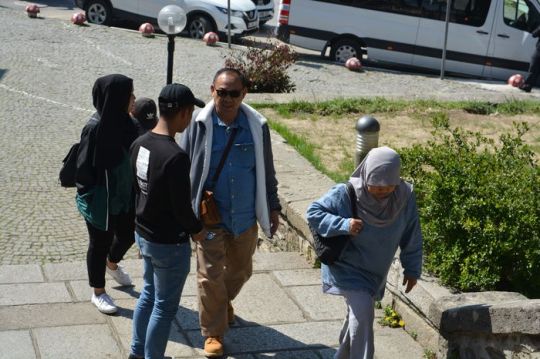
Yedi Kuleh Kapusu
The next gate is Yedi Kuleh Kapusu (Gate of the Seven Towers), the first public gate; a Byzantine Eagle carved on the inside is still visible. The tower to the right of this gate bears a Turkish inscription, and the date 1168 of the Hegira. The two medallions, of which traces are still visible, seem to have once been ornamented with carvings.
Yedi Kuleh (The Seven Towers) is the Byzantine citadel, variously styled Cyclobion or Strongylon, from its circular form, Pentapyrgion, from its five towers, and subsequently Heptapyrgion, on the increase of the number of towers to seven. The present towers were built on the site of the old ones by Sultan Muhammad II., and were used as a treasury. The wooden roofs were subsequently removed, owing to the frequent outbreaks of fire. Of the seven towers four are now left standing, the other three having been destroyed by an earthquake in 1758.
Treacherous intrigues of Sultan
The citadel served as a place of detention for state prisoners, many of whom were quietly strangled within its walls ; amongst others, Sultan Osman II., who, at the age of eighteen, fell a victim to the treacherous intrigues of Sultan Mustapha and the discontent of the mutinous Janissaries. In the Seven Towers it was also customary for the Turks, while hostilities lasted, to imprison the ambassadors of foreign countries with which the Porte was at war. The last ambassador thus detained was the French ambassador in 1798, who was kept imprisoned for three years. Since that date the pressure brought to bear upon the Porte by the French general Sebastiani, and the British ambassador Mr. Charles Arbuthnot, caused the Turks to give up this custom. Several Latin and French mural inscriptions on the left of the entrance to the dungeon have recently been effaced by some Turks.
This tower, which is at the E.S.E. corner of the citadel, contains a solid marble staircase leading to the top, and commands a splendid view of the Marmora shores, of Stambul and the outlying suburbs as far as San Stefano, and of the coast and mountains of Asia Minor and the Islands. The carving over the partly walled – up gate opposite the entrance leading to the Golden Gate represents the Labarum, the standard of the Byzantine Emperors. A flight of steps in a dark passage on the left of this gate leads to the dungeons to which obnoxious sultans were once consigned.
Only one of the two dungeons has two windows, and these too high and too small to have been any consolation to the unfortunate inmate, whose captivity, however, was in most cases terminated at an early stage by the bowstring. Visitors to this part of the citadel should provide themselves with a lantern, which is to be obtained from the doorkeeper. Several crosses are still to be seen carved over the gate opposite the Golden Gate. One of the graves under the laurel and pomegranate trees in the garden is that of Ahmed Kiupruli Pasha, who was hanged on his return from the taking of Candia after a twenty-four years’ siege. The Seven Towers and the adjoining land are now in charge of the Imperial Museum of Antiquities. Admission tc the citadel piastres (5d.) per person.
0 notes
Photo
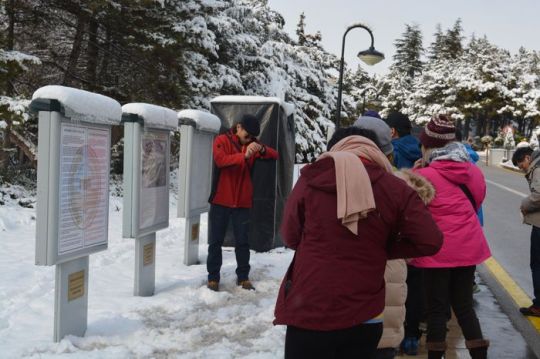
Yedi Kuleh Kapusu
The next gate is Yedi Kuleh Kapusu (Gate of the Seven Towers), the first public gate; a Byzantine Eagle carved on the inside is still visible. The tower to the right of this gate bears a Turkish inscription, and the date 1168 of the Hegira. The two medallions, of which traces are still visible, seem to have once been ornamented with carvings.
Yedi Kuleh (The Seven Towers) is the Byzantine citadel, variously styled Cyclobion or Strongylon, from its circular form, Pentapyrgion, from its five towers, and subsequently Heptapyrgion, on the increase of the number of towers to seven. The present towers were built on the site of the old ones by Sultan Muhammad II., and were used as a treasury. The wooden roofs were subsequently removed, owing to the frequent outbreaks of fire. Of the seven towers four are now left standing, the other three having been destroyed by an earthquake in 1758.
Treacherous intrigues of Sultan
The citadel served as a place of detention for state prisoners, many of whom were quietly strangled within its walls ; amongst others, Sultan Osman II., who, at the age of eighteen, fell a victim to the treacherous intrigues of Sultan Mustapha and the discontent of the mutinous Janissaries. In the Seven Towers it was also customary for the Turks, while hostilities lasted, to imprison the ambassadors of foreign countries with which the Porte was at war. The last ambassador thus detained was the French ambassador in 1798, who was kept imprisoned for three years. Since that date the pressure brought to bear upon the Porte by the French general Sebastiani, and the British ambassador Mr. Charles Arbuthnot, caused the Turks to give up this custom. Several Latin and French mural inscriptions on the left of the entrance to the dungeon have recently been effaced by some Turks.
This tower, which is at the E.S.E. corner of the citadel, contains a solid marble staircase leading to the top, and commands a splendid view of the Marmora shores, of Stambul and the outlying suburbs as far as San Stefano, and of the coast and mountains of Asia Minor and the Islands. The carving over the partly walled – up gate opposite the entrance leading to the Golden Gate represents the Labarum, the standard of the Byzantine Emperors. A flight of steps in a dark passage on the left of this gate leads to the dungeons to which obnoxious sultans were once consigned.
Only one of the two dungeons has two windows, and these too high and too small to have been any consolation to the unfortunate inmate, whose captivity, however, was in most cases terminated at an early stage by the bowstring. Visitors to this part of the citadel should provide themselves with a lantern, which is to be obtained from the doorkeeper. Several crosses are still to be seen carved over the gate opposite the Golden Gate. One of the graves under the laurel and pomegranate trees in the garden is that of Ahmed Kiupruli Pasha, who was hanged on his return from the taking of Candia after a twenty-four years’ siege. The Seven Towers and the adjoining land are now in charge of the Imperial Museum of Antiquities. Admission tc the citadel piastres (5d.) per person.
0 notes
Photo
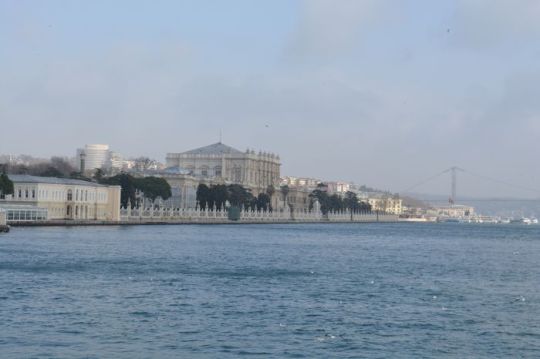
Yedi Kuleh Kapusu
The next gate is Yedi Kuleh Kapusu (Gate of the Seven Towers), the first public gate; a Byzantine Eagle carved on the inside is still visible. The tower to the right of this gate bears a Turkish inscription, and the date 1168 of the Hegira. The two medallions, of which traces are still visible, seem to have once been ornamented with carvings.
Yedi Kuleh (The Seven Towers) is the Byzantine citadel, variously styled Cyclobion or Strongylon, from its circular form, Pentapyrgion, from its five towers, and subsequently Heptapyrgion, on the increase of the number of towers to seven. The present towers were built on the site of the old ones by Sultan Muhammad II., and were used as a treasury. The wooden roofs were subsequently removed, owing to the frequent outbreaks of fire. Of the seven towers four are now left standing, the other three having been destroyed by an earthquake in 1758.
Treacherous intrigues of Sultan
The citadel served as a place of detention for state prisoners, many of whom were quietly strangled within its walls ; amongst others, Sultan Osman II., who, at the age of eighteen, fell a victim to the treacherous intrigues of Sultan Mustapha and the discontent of the mutinous Janissaries. In the Seven Towers it was also customary for the Turks, while hostilities lasted, to imprison the ambassadors of foreign countries with which the Porte was at war. The last ambassador thus detained was the French ambassador in 1798, who was kept imprisoned for three years. Since that date the pressure brought to bear upon the Porte by the French general Sebastiani, and the British ambassador Mr. Charles Arbuthnot, caused the Turks to give up this custom. Several Latin and French mural inscriptions on the left of the entrance to the dungeon have recently been effaced by some Turks.
This tower, which is at the E.S.E. corner of the citadel, contains a solid marble staircase leading to the top, and commands a splendid view of the Marmora shores, of Stambul and the outlying suburbs as far as San Stefano, and of the coast and mountains of Asia Minor and the Islands. The carving over the partly walled – up gate opposite the entrance leading to the Golden Gate represents the Labarum, the standard of the Byzantine Emperors. A flight of steps in a dark passage on the left of this gate leads to the dungeons to which obnoxious sultans were once consigned.
Only one of the two dungeons has two windows, and these too high and too small to have been any consolation to the unfortunate inmate, whose captivity, however, was in most cases terminated at an early stage by the bowstring. Visitors to this part of the citadel should provide themselves with a lantern, which is to be obtained from the doorkeeper. Several crosses are still to be seen carved over the gate opposite the Golden Gate. One of the graves under the laurel and pomegranate trees in the garden is that of Ahmed Kiupruli Pasha, who was hanged on his return from the taking of Candia after a twenty-four years’ siege. The Seven Towers and the adjoining land are now in charge of the Imperial Museum of Antiquities. Admission tc the citadel piastres (5d.) per person.
0 notes
Text
Athener Kaffee-Tagebuch: Thessaloniki - Castra All Day Terrace Bar
Dieser Besuch war tatsächlich von langer Hand geplant, weshalb ich die ohnehin schon phantastische Aussicht am Heptapyrgion auf Stadt, Meer und Sonnenuntergang zeitig verlassen musste. Denn am Heptapyrgion gibt es keinen Kaffee!
Den gibt es aber im Café Castra unmittelbar an der Stadtmauer und nur wenige Schritte vom Trigonenturm. Und ich habe großes Glück und ergattere einen der raren Plätze…

View On WordPress
#Cappuccino freddo#Cappuccino fredo#Castra#Castra All Day Terrace Bar#Freddo#Freddo Cappuccino#Fredo-Cappuccino#Heptapyrgion#Sonnenuntergang#Sundown#Thessaloniki#Trigonenturm
0 notes
Photo
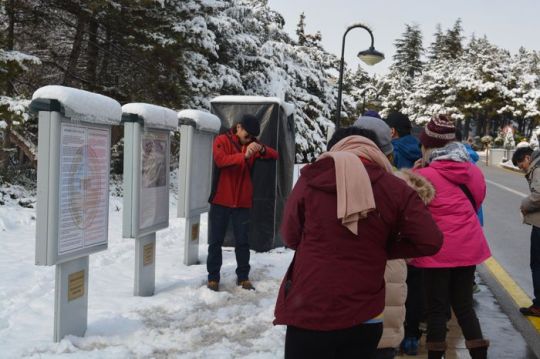
Yedi Kuleh Kapusu
The next gate is Yedi Kuleh Kapusu (Gate of the Seven Towers), the first public gate; a Byzantine Eagle carved on the inside is still visible. The tower to the right of this gate bears a Turkish inscription, and the date 1168 of the Hegira. The two medallions, of which traces are still visible, seem to have once been ornamented with carvings.
Yedi Kuleh (The Seven Towers) is the Byzantine citadel, variously styled Cyclobion or Strongylon, from its circular form, Pentapyrgion, from its five towers, and subsequently Heptapyrgion, on the increase of the number of towers to seven. The present towers were built on the site of the old ones by Sultan Muhammad II., and were used as a treasury. The wooden roofs were subsequently removed, owing to the frequent outbreaks of fire. Of the seven towers four are now left standing, the other three having been destroyed by an earthquake in 1758.
Treacherous intrigues of Sultan
The citadel served as a place of detention for state prisoners, many of whom were quietly strangled within its walls ; amongst others, Sultan Osman II., who, at the age of eighteen, fell a victim to the treacherous intrigues of Sultan Mustapha and the discontent of the mutinous Janissaries. In the Seven Towers it was also customary for the Turks, while hostilities lasted, to imprison the ambassadors of foreign countries with which the Porte was at war. The last ambassador thus detained was the French ambassador in 1798, who was kept imprisoned for three years. Since that date the pressure brought to bear upon the Porte by the French general Sebastiani, and the British ambassador Mr. Charles Arbuthnot, caused the Turks to give up this custom. Several Latin and French mural inscriptions on the left of the entrance to the dungeon have recently been effaced by some Turks.
This tower, which is at the E.S.E. corner of the citadel, contains a solid marble staircase leading to the top, and commands a splendid view of the Marmora shores, of Stambul and the outlying suburbs as far as San Stefano, and of the coast and mountains of Asia Minor and the Islands. The carving over the partly walled – up gate opposite the entrance leading to the Golden Gate represents the Labarum, the standard of the Byzantine Emperors. A flight of steps in a dark passage on the left of this gate leads to the dungeons to which obnoxious sultans were once consigned.
Only one of the two dungeons has two windows, and these too high and too small to have been any consolation to the unfortunate inmate, whose captivity, however, was in most cases terminated at an early stage by the bowstring. Visitors to this part of the citadel should provide themselves with a lantern, which is to be obtained from the doorkeeper. Several crosses are still to be seen carved over the gate opposite the Golden Gate. One of the graves under the laurel and pomegranate trees in the garden is that of Ahmed Kiupruli Pasha, who was hanged on his return from the taking of Candia after a twenty-four years’ siege. The Seven Towers and the adjoining land are now in charge of the Imperial Museum of Antiquities. Admission tc the citadel piastres (5d.) per person.
0 notes
Photo

Yedi Kuleh Kapusu
The next gate is Yedi Kuleh Kapusu (Gate of the Seven Towers), the first public gate; a Byzantine Eagle carved on the inside is still visible. The tower to the right of this gate bears a Turkish inscription, and the date 1168 of the Hegira. The two medallions, of which traces are still visible, seem to have once been ornamented with carvings.
Yedi Kuleh (The Seven Towers) is the Byzantine citadel, variously styled Cyclobion or Strongylon, from its circular form, Pentapyrgion, from its five towers, and subsequently Heptapyrgion, on the increase of the number of towers to seven. The present towers were built on the site of the old ones by Sultan Muhammad II., and were used as a treasury. The wooden roofs were subsequently removed, owing to the frequent outbreaks of fire. Of the seven towers four are now left standing, the other three having been destroyed by an earthquake in 1758.
Treacherous intrigues of Sultan
The citadel served as a place of detention for state prisoners, many of whom were quietly strangled within its walls ; amongst others, Sultan Osman II., who, at the age of eighteen, fell a victim to the treacherous intrigues of Sultan Mustapha and the discontent of the mutinous Janissaries. In the Seven Towers it was also customary for the Turks, while hostilities lasted, to imprison the ambassadors of foreign countries with which the Porte was at war. The last ambassador thus detained was the French ambassador in 1798, who was kept imprisoned for three years. Since that date the pressure brought to bear upon the Porte by the French general Sebastiani, and the British ambassador Mr. Charles Arbuthnot, caused the Turks to give up this custom. Several Latin and French mural inscriptions on the left of the entrance to the dungeon have recently been effaced by some Turks.
This tower, which is at the E.S.E. corner of the citadel, contains a solid marble staircase leading to the top, and commands a splendid view of the Marmora shores, of Stambul and the outlying suburbs as far as San Stefano, and of the coast and mountains of Asia Minor and the Islands. The carving over the partly walled – up gate opposite the entrance leading to the Golden Gate represents the Labarum, the standard of the Byzantine Emperors. A flight of steps in a dark passage on the left of this gate leads to the dungeons to which obnoxious sultans were once consigned.
Only one of the two dungeons has two windows, and these too high and too small to have been any consolation to the unfortunate inmate, whose captivity, however, was in most cases terminated at an early stage by the bowstring. Visitors to this part of the citadel should provide themselves with a lantern, which is to be obtained from the doorkeeper. Several crosses are still to be seen carved over the gate opposite the Golden Gate. One of the graves under the laurel and pomegranate trees in the garden is that of Ahmed Kiupruli Pasha, who was hanged on his return from the taking of Candia after a twenty-four years’ siege. The Seven Towers and the adjoining land are now in charge of the Imperial Museum of Antiquities. Admission tc the citadel piastres (5d.) per person.
0 notes
Text

Thessaloniki, View from Eptagyrion
#erasmus in thessaloniki#thessaloniki#greece#upper town#ocean view#view#akropolis#acropolis#heptapyrgion#Επταπύργιο#Festung#Byzanz#byzantium#greek history#greek#greek architecture#greek aesthetic#greek posts
35 notes
·
View notes